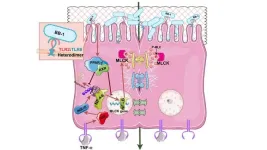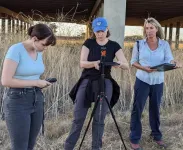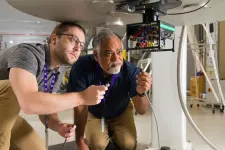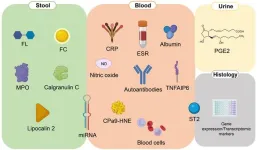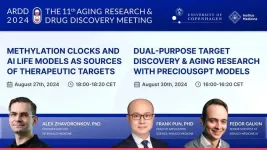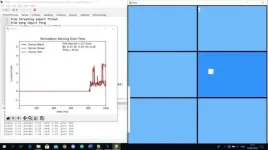(Press-News.org) Many quantum devices, from quantum sensors to quantum computers, use ions or charged atoms trapped with electric and magnetic fields as a hardware platform to process information.
However, current trapped-ion systems face important challenges. Most experiments are limited to one-dimensional chains or two-dimensional planes of ions, which constrain the scalability and functionality of quantum devices. Scientists have long dreamed of stacking these ions into three-dimensional structures, but this has been very difficult because it’s hard to keep the ions stable and well-controlled when arranged in more complex ways.
To address these challenges, an international collaboration of physicists from India, Austria, and the USA—including JILA and NIST Fellow Ana Maria Rey, along with NIST scientists Allison Carter and John Bollinger—proposed that tweaking the electric fields that trap the ions can create stable, multied structures, opening up exciting new possibilities for future quantum technologies. The researchers published their findings in Physical Review X.
“The capability to trap large ensembles of ions in two or more spatially separated layers under fully controllable conditions opens exciting opportunities to explore new regimes and phenomena not easily accessible in purely 2D crystals, such as topological chiral modes, teleportation and precision measurements of spatially varying fields all relevant for quantum information science,” says Rey.
Using Penning traps
Among the various platforms being explored for quantum computing, trapped ions have emerged as a leading candidate due to their high degree of controllability and the ability to perform precise quantum operations. These ions can be manipulated with laser or microwave pulses, which change their quantum states, allowing them to be “coded” with specific information. These coded ions are often called quantum bits or “qubits.”
During this process, ions also experience the Coulomb force or interactions with other ions, which physicists can use to entangle them, reducing the system's overall noise and enhancing its measurements.
“Previous work has shown that ion crystals can form 3D spheroidal structures, but what we were looking for was a way to realize a stacked array of 2D layers,” Samarth Hawaldar, the paper’s first author and a researcher at the Indian Institute of Science, explained in a recent write up about the paper. “We started to explore ways to realize such structures in a specific type of ion trap called a Penning trap, because these traps are good at storing large numbers of ions, typically many hundreds to thousands.”
In a Penning trap, ions can be forced to self-ensemble into crystalline structures generated by the competition between repulsive Coulomb interactions and the confinement potential—the combined electric and magnetic force that keeps ions securely trapped in a specific region of space.
“Confinement is achieved via electromagnetic forces created by a stack of electrodes and by making the ions rotate in a powerful magnetic field,” explains Carter.
For physicists, Penning traps are particularly useful because they can store a large number of ions, making them a good option for experimenting with more complex, three-dimensional structures. Penning traps have been used to arrange ions into a single, two-dimensional layer or more rounded, three-dimensional shapes. The rounded, three-dimensional shape happens because the confining electric field in these traps usually increases linearly with distance from the trap's center, like that of an ideal spring, naturally guiding the ions into these simpler, rounded formations.
However, the researchers tried modifying the trap's electric field to be more nuanced and dependent on the distance from the center of the trap. This subtle change allowed them to coax the ions into forming a new kind of structure—a bilayer crystal, where two flat layers of ions were stacked one above the other.
The team conducted extensive numerical simulations to validate their new approach, showing that this bilayer configuration could be stabilized under certain conditions and even suggesting the potential to extend the method to create crystals with more than two layers.
“We’re excited to try forming bi-layer crystals in the lab with our current Penning trap set-up,” says John Bollinger, an experimental physicist and co-author of the publication. “In the longer term I think this idea will motivate a redesign of the detailed electrode structure of our traps.”
A new frontier for ion trapping
Shifting ion trapping from 2D to 3D has significant implications for the future of quantum devices such as sensors or quantum computers.
“Bilayer crystals open up several new capabilities for quantum information processing that are not straightforward with 1D chains or 2D planes,” Dr. Athreya Shankar, a postdoctoral researcher at the Indian Institute of Science, said in a recent statement about the study.
“For instance, the generation of quantum entanglement between large sub-systems separated by a distance, such as the two layers in this system, is a sought-after capability across all quantum hardware.
The team is eager to test these findings experimentally in their Penning traps. If successful, this could lead to new quantum hardware architectures that make more efficient use of 3D space, thus increasing the scalability and robustness of quantum technologies.
Besides hardware opportunities, the bilayers open new quantum simulations and sensing possibilities.
“For example, the normal modes of the ions in a bilayer can couple both vertical and radial degrees of freedom, favoring the clock over anti-clockwise circulation or vice versa,” Rey elaborates. “This could be used to imitate rich behaviors experienced by electrons in strong magnetic fields but under fully controllable settings. Moreover, having more ions can enhance signal-to-noise in measurement and thus enable more precise estimation of quantities such as time, electric fields, or accelerations, which can be very important for discovering new physics.”
This partnership between researchers in India, Austria and the USA is critical as the field of quantum technology continues to evolve. Innovations like these will be vital in realizing the full potential of quantum computing, sensing, and beyond.
This work was supported by the U.S. Department of Energy’s Office of Science, The National Quantum Initiative (NQI) Science Research Centers, and the Quantum Systems Accelerator (QSA).
END
A 3D ion Magnet, the new experimental frontier for quantum information processing
2024-08-22
ELSE PRESS RELEASES FROM THIS DATE:
A potential pathway may guide new therapies for inflammatory bowel disease and other inflammatory diseases
2024-08-22
Philadelphia, August 22, 2024 – There is a critical unmet need to help tighten and maintain a healthy intestinal barrier and treat a leaky gut. Researchers have now found that a unique strain of probiotic bacteria, Bifidobacterium bifidum BB1, enhances intestinal barrier function and protects against penetration of bacteria and various harmful agents in the intestine. The findings, detailed in an article in The American Journal of Pathology, published by Elsevier, can help advance the development of novel, targeted, naturally occurring probiotic therapy for patients with inflammatory bowel disease (IBD) and other inflammatory diseases, such as fatty liver disease or alcoholic liver ...
CU researchers awarded $1.35 million grant to develop decision support technology for long-term care facilities
2024-08-22
Researchers from the University of Colorado College of Nursing and CU School of Medicine on the Anschutz Medical Campus were awarded a $1.35 million grant from the Agency for Healthcare Research and Quality (AHRQ) to design and implement technologies that improve resident safety and employee wellbeing at long-term care facilities.
“Long-term care facilities in the United States are in crisis, they’re facing low resources and high staff turnover,” CU Nursing Associate Professor and ...
Alzheimer’s drug may someday help save lives by inducing a state of “suspended animation”
2024-08-22
Researchers at the Wyss Institute for Biologically Inspired Engineering at Harvard University report that they were able to successfully put tadpoles of Xenopus laevis frogs into a hibernation-like torpor state using donepezil (DNP), a drug approved by the FDA to treat Alzheimer’s. The team had previously used another drug, SNC80, to achieve similar results in tadpoles and enhance the survival of whole mammalian hearts for transplants, but SNC80 is not approved for clinical use in humans because it can cause seizures. By contrast, DNP is already being used in the clinic, meaning it potentially could be rapidly repurposed ...
New NSF Center for Pandemic Insights
2024-08-22
Preventing the next pandemic begins before diseases emerge. This “pre-emergence” phase is the focus of a new center funded by the U.S. National Science Foundation and led by the University of California, Davis.
Supported with $18 million over seven years, the U.S. National Science Foundation Center for Pandemic Insights (NSF CPI) includes partnering institutions from across the United States. It aims to harness new technologies and develop sensing to detect, investigate, and ultimately prevent ...
FAMU-FSU College of Engineering research shows how insulin, zinc and pH can block harmful protein clumps linked to Type 2 diabetes
2024-08-22
An estimated 462 million people around the world suffer from Type 2 diabetes, a chronic disease in which the body has problems using sugar as a fuel, leading to a buildup of sugar in the blood and chronic health issues.
New research led by Ayyalusamy Ramamoorthy, a professor at the FAMU-FSU College of Engineering and the Florida State University-headquartered National High Magnetic Field Laboratory, shows how zinc, pH levels and insulin work together to inhibit the buildup of protein clumps that contribute to this disease. The work, which points toward promising avenues for innovative treatments, ...
Fecal, blood, and urinary biomarkers in inflammatory bowel diseases
2024-08-22
The global burden of inflammatory bowel diseases (IBD), primarily Crohn's disease (CD) and ulcerative colitis (UC), continues to rise. Recent data show incidence rates of up to 17.8 cases per 100,000 person-years for CD and even higher for UC, reaching 28.4 per 100,000 person-years. These diseases primarily affect older populations and vary geographically, with higher prevalence rates in highly developed countries. Currently, endoscopic assessment through ileo-colonoscopy is the gold standard for diagnosing and monitoring IBD. However, this approach is invasive and often has limited availability, leading to long ...
ARDD 2024 | What can we do before the "cliff" of aging arrives?
2024-08-22
When exactly does the aging process start? With the aging mechanisms unclear, no consensus has been reached about aging “cliffs”, where our body functions and biological processes just change dramatically, as if overnight.
In 2019, a study published in the authoritative peer-reviewed journal Nature Medicine, based on plasma proteomics data, identified 34, 60, and 78 years old as key time points of aging. In August 2024, Nature Aging, a Nature portfolio journal focusing on aging mechanisms, published the latest findings incorporating comprehensive data including transcriptomics and metabolomics, pinpointing the aging cliffs to the 40s and 60s.
In the biomedical field, multi-omics ...
Hydrogels can play Pong by “remembering” previous patterns of electrical simulation
2024-08-22
Non-living hydrogels can play the video game Pong and improve their gameplay with more experience, researchers report August 23 in the Cell Press journal Cell Reports Physical Science. The researchers hooked hydrogels up to a virtual game environment and then applied a feedback loop between the hydrogel’s paddle—encoded by the distribution of charged particles within the hydrogel—and the ball’s position—encoded by electrical stimulation. With practice, the hydrogel’s accuracy improved by up to 10%, resulting in longer rallies. The researchers say that this demonstrates ...
Precision drug olaparib may be effective without hormone therapy for some men with biochemically recurrent prostate cancer
2024-08-22
The anti-cancer drug olaparib may be effective in treating biochemically recurrent prostate cancer without accompanying hormone therapy for men who have mutations in genes such as BRCA2, according to results of a phase II clinical trial of 51 patients conducted at the Johns Hopkins Kimmel Cancer Center and three other sites.
The study was done of men experiencing signs of cancer recurrence after surgical removal of the prostate, as measured by a high level of the protein prostate-specific antigen (PSA). Following treatment with olaparib, 13 participants, including all 11 who had BRCA2 mutations, had a decrease in PSA of at least 50% ...
Americans face disparities in exposure to tobacco on streaming platforms
2024-08-22
Tens of millions of Americans are being exposed to tobacco content on streaming services, according to new research from The University of Texas MD Anderson Cancer Center. The researchers found that the odds of encountering tobacco products being advertised, marketed or promoted on these platforms increased based on race, ethnicity, socioeconomic status and smoking habits.
The nationally representative study, published today in JAMA Network, revealed an estimated 12.4% of American adults were exposed to tobacco promotion on streaming services. Exposure was highest among those with a high school education or less (16.4%), Black/African American respondents (19.4%), ...
